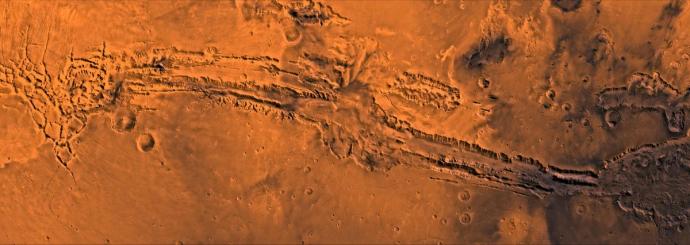Mars is the fourth planet out from the Sun. It is also the second smallest planet in the Solar System after Mercury.
Mars is a terrestrial planet like Earth. This means that it has a solid surface you could stand on. It is made of minerals, metals and other elements that make up rock.
Mars is often called the Red Planet. This is because it is covered with lots of iron oxide (or rust) giving it a reddish colour. It has two tiny, potato-shaped moons called Phobos and Deimos.
Mars is about half the diameter of Earth. As it is smaller in both size and mass the gravity on Mars is about 40% of that on Earth. Mars has a thin atmosphere mainly made of carbon dioxide (95%), argon (2%) and nitrogen (2%).
Mars has huge dust storms which can cover the entire planet and change how the surface looks. It also has polar ice caps mostly made of frozen water. There are lots of features on Mars which look like they were created by moving water a long time ago. If there once was liquid water on Mars it is possible that there was life.
Mars is home to the largest volcano in the Solar System which is called Olympus Mons. It is about 3 times higher than Mount Everest on Earth. It also has the largest canyon in the Solar System called Valles Marineris. This canyon is more than 10 times longer than the Grand Canyon on Earth. If placed on Earth it would stretch across the whole of the United States.
Humans have sent probes to Mars since 1964. It's the only planet which robot rovers have landed on. There are still 2 rovers exploring the surface today; Curiosity (which landed in 2012) and Perseverance. Perseverance landed in February 2021 carrying on board a small helicopter. This helicopter was the first machine to have powered flight on another world! It was joined in May 2021 by the Chinese rover Zhurong Mars. They are all exploring the surface of Mars looking for signs of life.

- Moons
Mars has two moons called Phobos and Deimos. The planet Mars is named after the Roman god of war. As such the moons are called Phobos, which means 'fear' or 'panic', and Deimos, meaning 'terror' or 'dread'.
The moons were discovered in 1877, and there is still much debate about where they came from. The moons look very similar to asteroids. Many people think that they once lived in the asteroid belt and were pulled to Mars by its gravity. Others think that when Mars first formed it was surrounded by lots of objects. Most moved out to the asteroid belt, but Phobos and Deimos remained.
Phobos orbits really close to Mars, closer than any other moon in the Solar System. It is travelling so fast that if orbits the planet three times each day! It is also very small. It reflects very little light from the Sun, so it does not appear very bright in the sky.
Deimos orbits Mars much further away than Phobos. It is slightly smaller than the other moon, making it very faint in the sky. It is made from similar materials to other asteroids, carbon rocks and ice. It is much less cratered on the surface though, meaning it has been hit by space debris less often.
Just like Earth's Moon, both of Mars's moons always show the same side to the planet.
Image CreditThis work by NASA/JPL-Caltech/GSFC/Univ. of Arizona is licensed under Creative Commons Zero v1.0 Universal
CreditThis work by NASA/JPL-Caltech/GSFC/Univ. of Arizona is licensed under Creative Commons Zero v1.0 UniversalMontage of Mars's two moons
